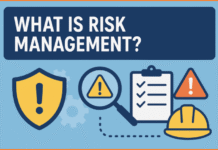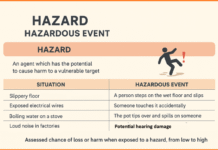Main areas of inspection are tabulated as under-
Inspection Areas
Standard Conditions of Process & Storage
- Initial information
- Process description
- Operating instructions
Plant Integrity
- Safe working limits
- Design, construction, inspection, test and certification
- Protective devices
- Maintenance
- Inspection & testing
- Inspection authority
- Evaluation of plant integrity
- Vessels
- Pipelines
- Pumps & ancillary equipment
- Modification to plant & equipment
- Management control
Process Deviations
- Variables
- Process chemistry
- Pressure
- Temperature
- Level
- Flow rate
- Impact
- Services
- Start-up & shutdown
- Operators error
- Sensory failure
- Failure in logic
- Failure to act properly
Emergency Procedure and Fire precautions
Some salient points on above areas are summarised below:
- Serious incidents arise from loss of containment of hazardous substances. Therefore these possibilities and plant items should be inspected in details.
- The most vulnerable parts of the plant, procedure or system should be identified from going through the plant layout, process flow diagram and walking round the installation. Records of failure history and past accidents are useful.
- Safety arrangements should be checked also in relation to off-site impact with the local population.
- All available expertise should be applied e.g. engineering, chemical, medical, management etc. A meeting and discussion with the experts in the plant can be useful.
- Competency of the occupier and contractors should be verified regarding better choice of process, catalyst, equipment etc. Operating pressure, temperature, residence time etc. and management control systems.
- Process documents like process description, operating procedures, safety information, emergency manual etc. should be scrutinised for completeness and quality.
- Process description should be inclusive of principles involved, basic chemistry of main and side reactions, hazards of materials and safety precautions, plant, equipment list and line diagram, transport, storage and transfer arrangements, operating parameters and their safe limits, SOPs and procedure for authorising process change.
- Operating instructions should include flow sequence & bath sheet, conditions to be maintained, actions of process controls and monitoring instruments, allowable variation limits and action necessary when that limit is reached emergency procedure, reporting route and training schedule of operators.
- For plant integrity, safe working limits of plant (including pressure vessels) should be carefully established as design data and compatible with normal process operating conditions.
- The design data should include the range of pressure, temperature, loading, flow rates operation cycle, basis for pressure relief and properties of substances.
- The plant should be designed, constructed inspected, tested and certified according to the design and construction code which will achieve the safe working limits.
- Protective devices may include pressure/vacuum relief valves, rupture discs, explosion vents, high/ low level alarms, high/low temperature/pressure alarm, weight tables, content gauges, maximum fill devices, padding air/gas reducing valves and many forms of instrumentation. Such devices should be checked for its suitability for the purpose intended.
- Safe systems of work may include manual venting procedures, loading/unloading systems and temperature control at fill cold content stored below their safe temperature may cause brittle.
- A scheme of testing protective device should be made by a competent person with due regard to local conditions (e.g. environment), consequences of failure, duplication, fail safe provision and risk physical damage.
- Preventive and conditions-based maintenance schemes should be established.
- The plant should be periodically and appropriately inspected and tested. The vessel should be reassessed for continued use with particular contents and the safe working limits confirmed or revised. Pressure limits should be revised if the thickness is found reduced. Certification should specify safe working pressure, vacuum, temperature, load and fill ratio where the content may expand with temperature rise and date of next examination.
- Pressure vessels should be inspected as per statutory requirements. The date of next inspection should be certified by the competent person.
- Pipelines, pumps and ancillary equipment should also be periodically inspected and maintained. Colour code should be followed. Where failure can be hazardous, standby equipment should be provided (e.g. Diesel driven fire pump, scrubber pump, stand-by power generator etc). Emergency procedure should be available in case of pump or equipment failure.
- Modifications to plant and equipment should be of a standard of original integrity, otherwise the plant should be down-rated. The modification should be tested and certified by a competent person for use and ability.
- All process deviations which may affect the plant in relation to loss of containment should be scrutinised and the occupier’s competence to prevent losses should be technically appraised. Such deviations concern process chemistry, pressure, temperature, flow rate, liquid level, viscosity, surface tension, pH, moisture content, contaminants, presence or absence of air/oxygen/ inert gas etc. impacts by external forces like vehicles, falling bodies etc. utility services, start-up and shutdown abnormalities and operators errors such as sensory failure, failure in logic (judgement or decision) and failure to act properly (omission) or acting improperly (commission).
Training can do little to anticipate these errors but good process design can minimise their effect and ensure that no single mistake will be capable of causing catastrophe. Effective supervision, check-lists and work permit system can reduce the incidence of errors. Causes of pressure rise are failure of pressure protection or regulating system temperature rise, exothermic, run-away or polymerisation reaction, back feeding of reaction mass into storage vessel etc. It can result in fire explosion or / and toxic release.
Causes of temperature rise are failure of heat control, failure of cooling system, fire, exothermic reaction etc. It may result in rise of pressure, flow rate, filling ratio, foaming of vessel content, rollover, and irreversible metallurgical change to vessel. It needs immediate venting or dumping.
Causes of level rise are failure of overfill prevention device, overflow device, level control device, communication between operators, misrouting of process streams, siphoning, loss of vacuum/pressure, surging etc. It may result in overflow, spillage or vessel rupture.
Causes of flow rate deviations (too high, too low or reversed) are changes in differential pressure, failure or furring up of pumps, pipelines and ancillaries, loss of pump prime, vapour lock, operator’s error etc. It may result in pressure/temperature deviations, rupture of process heater or heat-exchanger, erosion or cavitations within pipes and pumps.
Criteria of investigation include sizing and location of pipes, pumps, vents, flares etc. Isolation valves, gravity discharge, flexible connections etc.
Thus types of process deviations are many and so are their effects. Inspection process or checklist should pay due attention on them.
- Emergency procedures include physical controls, systems of work and emergency plans (e.g. on- site/off-site emergency plan). Operators should be trained for emergency shutdown action when and how to be followed and when to consult senior officials. Procedures for quick stopping the reaction, dumping or flaring and by-passing the content should be established.
To control or mitigate effects of heavy spillage, measures like bunding extra tank, catchment pits, dump vessels, diversion walls grading of the ground and use of absorbents or super-sucker etc. are required. Bund walls should withstand thermal shock, hydrostatic loading and corrosively of the chemical. For highly liquefied flammable gases like LPG, a remote evaporation area and sloppy floor are required. For toxic or cryogenic liquids, surface area should be minimised to reduce the evaporation, or suitable blanking material should be sprayed. Possible adiabatic flashing may also be considered.
Effects of explosion can be reduced by impact walls near chances of explosion. Integrity of control room should be ascertained. Storage quantity and length and size of pipe-work should be minimized. Vessel outlets and fixed pipe-work should have remotely operated isolation valves.
Necessary personal protective equipment conforming to Indian Standards should be given to workers and well maintained. Workers should be trained to use them.
- Fire protection for process and storage should be sufficient. Space separation, water drench, insulation, fire walls, adequacy of the fire water storage their pumps and equipment, portable extinguishers, fixed fire control installations, hoses, staff and regular fire-drills etc. should be verified.





